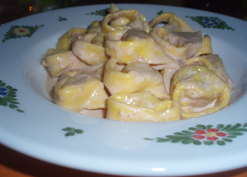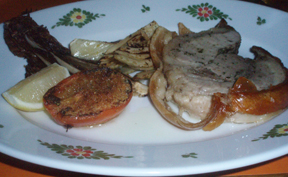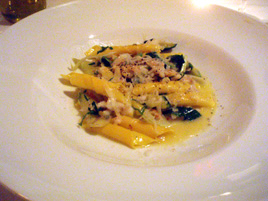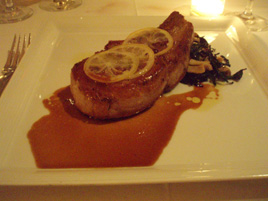All'onda
 Tuesday, February 25, 2014 at 06:46AM
Tuesday, February 25, 2014 at 06:46AM 
 Welcome back! It’s been far too long since Chris Jaeckle earned three stars at Ai Fiori, and since Chris Cannon ran what were arguably the best Italian restaurants in New York. Mario Batali and Joseph Bastianich might disagree with me about that last statement, but if it comes down to pistols at dawn, I’ll take Cannon’s side.
Welcome back! It’s been far too long since Chris Jaeckle earned three stars at Ai Fiori, and since Chris Cannon ran what were arguably the best Italian restaurants in New York. Mario Batali and Joseph Bastianich might disagree with me about that last statement, but if it comes down to pistols at dawn, I’ll take Cannon’s side.
Jaeckle and Cannon have now opened All’onda (named for a style of soupy risotto served in Venice) in a smart casual space near Union Square. The cuisine is dubbed Venetian, although most diners won’t know the difference. Early publicity mentioned Japanese influences (Jaeckle once worked at Morimoto), which have since (quite sensibly) receded.
For the record, restaurateur Jeffrey Chodorow is an investor here, but his China Grill Management does not operate it, which is why it doesn’t suck. Let us all say a prayer that Chodorow will never operate another restaurant again.
 To recite the history just briefly: Cannon was in partnership with the chef Michael White at two terrific Italian restaurants, Alto and L’Impero (later rechristened Convivio). At the height of the Great Recession, they brought in high-roller Ahmass Fakahany as an investment partner and opened Marea, taking a big bet on fine dining at a time when everyone else was running the opposite way.
To recite the history just briefly: Cannon was in partnership with the chef Michael White at two terrific Italian restaurants, Alto and L’Impero (later rechristened Convivio). At the height of the Great Recession, they brought in high-roller Ahmass Fakahany as an investment partner and opened Marea, taking a big bet on fine dining at a time when everyone else was running the opposite way.
Soon, they were rolling in dough and opened two more Italian restaurants, Ai Fiori and Osteria Morini. At about that time, and for reasons that have never been fully explained, Fakahany and White ditched Cannon, who was left with just his two original restaurants, Alto and Convivio. Shortly thereafter, both places closed suddenly—on the same day, in fact—and Cannon headed home to New Jersey.
 For more than three years, Cannon didn’t say a word about the split, and a recent interview with the Village Voice still leaves many questions unanswered. It ought to be noted that Cannon is no stranger to culinary divorces, having suffered a similar split with the chef Scott Conant.
For more than three years, Cannon didn’t say a word about the split, and a recent interview with the Village Voice still leaves many questions unanswered. It ought to be noted that Cannon is no stranger to culinary divorces, having suffered a similar split with the chef Scott Conant.
Jaeckle left Ai Fiori (which Cannon had helped open) in November 2011, and it wasn’t difficult to guess that he wanted his own place. All’onda was announced in September 2012, with Cannon on board as a consultant while his newest project, Jockey Hollow, remained under construction at the Vail Mansion in Morristown, New Jersey.
Originally announced for a November 2012 opening, All’onda endured all of the usual delays, and finally served its first risotto in early January 2014. A photographer with a tripod was shooting the space when we visited, so the first pro reviews will probably start to appear within the next week or so.

All’onda, as Chris Jaeckle told the Times, is “the most casual restaurant I’ve ever worked in.” That is probably almost true for Chris Cannon as well, at least since he became famous: except for Osteria Morini, opened in his dying days with White and Fakahany, he’s known almost exclusively for fine dining.
 They probably could have aimed higher. With the Torrisi boys serving $30 pastas and $50 veal parmesan to packed houses at Carbone, All’onda is a steal, with no pasta above $19 and no entrée above $29.
They probably could have aimed higher. With the Torrisi boys serving $30 pastas and $50 veal parmesan to packed houses at Carbone, All’onda is a steal, with no pasta above $19 and no entrée above $29.
The ten-page wine list, Cannon’s specialty, has plenty of drinkable bottles below $50, and about 90% of the list is below $100; they serve it in the right glassware. In a town where $15 cocktails are commonplace, and the Torrisi team gets $20 at ZZ’s Clam Bar, they’re just $12 here. I enjoyed the Basil Gimlet (photo above; with gin, lime, basil syrup), and they transferred the tab to our table. I splurged just slightly on the wine (a 2007 Travaglini, $65), ordered an after-dinner drink, and still kept the bill below $200 (before tip).
For a restaurant of this quality, All’onda is remarkable. Of course, if the reviews are as favorable as I believe they will be, these prices won’t last. They never do.








































